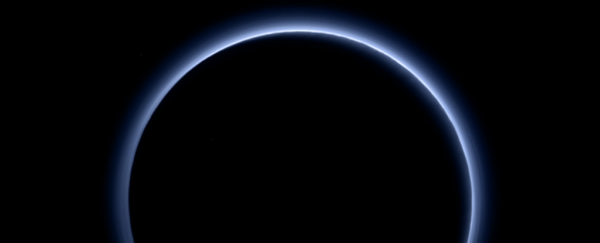The growing list of mysteries surrounding Pluto just got longer. On October 8, NASA released the first color photo of Pluto's atmosphere, and the shade they saw was anything but expected. It's BLUE! Just like Earth's.
"Who would have expected a blue sky in the Kuiper Belt? It's gorgeous," Alan Stern, who is the principal investigator for the New Horizons team, said in a NASA press release.
NASA's New Horizons spacecraft flew by Pluto on July 14, making history as the first spacecraft to get an up-close look at this distant world floating in space more than 4.5 billion miles from Earth. But the spacecraft didn't show us Pluto's atmosphere until after its closest approach. That's because scientists need an eclipse in order to observe a body's atmosphere.
So, after passing Pluto on July 14, the New Horizons spacecraft re-oriented its camera so that it could take a photo of Pluto's eclipse of the Sun. What you're seeing in the original black-and-white photo below is the Sun's light passing through Pluto's atmosphere before reaching New Horizon's LORI camera.
 NASA/JHUAPL/SwRI
NASA/JHUAPL/SwRI
Even with the release of this photo, scientists are flabbergasted. Pluto's atmosphere extends to about 1,000 miles (1,609 km) above its surface - higher than Earth's atmosphere and much further than scientists could have ever anticipated.
Now, the New Horizons spacecraft has successfully transmitted additional data taken by some of its other instruments on board that help identify the colour of Pluto's surface and atmosphere.
Take note: A blue atmosphere does not mean Pluto is teaming with life. Rather, it gives planetary scientists a better idea of both the size and composition of the types of particles that comprise the dwarf planet's atmosphere.
"A blue sky often results from scattering of sunlight by very small particles," said science team researcher Carly Howett. "On Earth, those particles are very tiny nitrogen molecules. On Pluto they appear to be larger - but still relatively small - soot-like particles we call tholins."
Tholins are a type of molecule that form when simpler compounds are exposed to UV light. Therefore, scientists suspect these tholins are first forming high in Pluto's atmosphere. But over time, the tholins fall toward the surface, combining with other molecules on their way down and subsequently adopting a brownish red colour, which could contribute to Pluto's iconic red colouring:
 NASA/JHUAPL/SwRI
NASA/JHUAPL/SwRI
Since its closest approach to Pluto, the New Horizons spacecraft has traveled an additional 500 million miles (804 millon km) and is now 3.1 billion miles (4.9 billion km) from Earth. NASA reports that its systems are "healthy and operating normally".
This article was originally published by Business Insider.
More from Business Insider:
